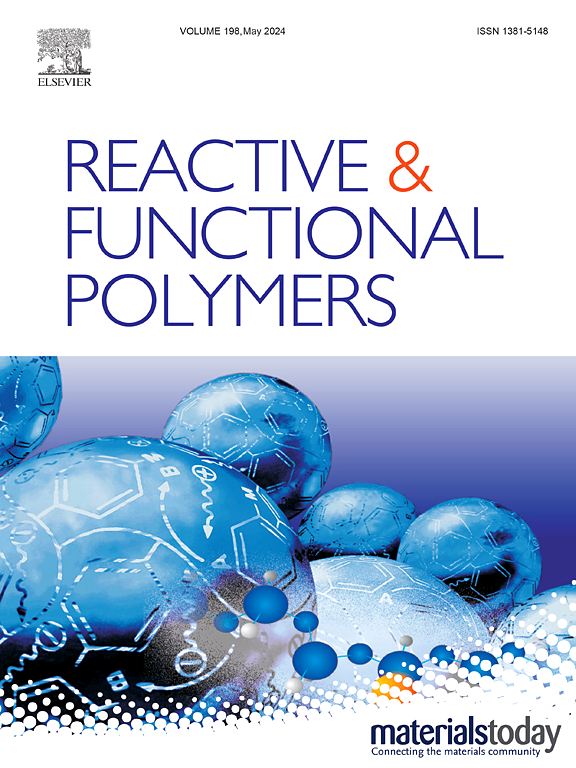Synthesis and chemical recycling investigations of polythioureas
IF 4.5
3区 工程技术
Q1 CHEMISTRY, APPLIED
引用次数: 0
Abstract
There is currently intensive research on the development of biobased polymers as potential alternatives to the environmentally hazardous isocyanate-based polyurethanes. In this context, polythioureas (PTUs) form a particularly attractive target because they can be synthesized by using isothiocyanates, a class of molecules that can be found in nature with expected low toxicity. Herein, a series of 16 PTUs with varied chemical structures, mostly being new polymers, have been synthesized and their possible chemical recycling pathways via thermally induced and acid-catalyzed depolymerizations have been investigated. The obtained PTUs showed a varied range of molecular weights (up to Mn ∼ 69.5 kDa), intrinsic viscosity (up to ∼6 dL/g), and glass transition temperatures (Tg ∼ 59–128 °C). Notably, we observed that the presence of aromatic segments lowered the thermal stability of the polymers, so they were generally easier to depolymerize (compared to those without aromatic groups), forming oligomers with controlled end-groups (i.e. telechelic polymers) that could be repolymerized. The obtained aliphatic PTUs were generally resistant against thermochemical depolymerizations, but they could be effectively depolymerized by sulfuric acid. The repolymerization methods depended on the end groups of the depolymerized products, which in this work included direct repolymerization of polythioureas (if the end groups contain ∼1:1 of isothiocyanates and amines) and copolymerizations with another monomer terephthaldehyde (if the end groups contain only amines). Our results provided a first comprehensive molecular insight into the synthetic and recycling possibilities of using isothiocyanates and polythioureas in the exploration of potential alternatives for isocyanates and polyurethanes.

聚硫脲的合成和化学回收研究
目前,人们正在深入研究开发生物基聚合物,以替代对环境有害的异氰酸酯基聚氨酯。在这方面,聚硫脲(PTUs)是一个特别有吸引力的目标,因为它们可以通过使用异硫氰酸酯合成,而异硫氰酸酯是一类可以在自然界中找到的分子,具有预期的低毒性。本文合成了一系列化学结构各异的 16 种 PTU,其中大部分为新型聚合物,并研究了它们通过热诱导和酸催化解聚可能的化学循环途径。所获得的 PTU 显示出不同的分子量范围(最大 Mn ∼ 69.5 kDa)、固有粘度(最大 ∼ 6 dL/g)和玻璃化转变温度(Tg ∼ 59-128 °C)。值得注意的是,我们观察到芳香族段的存在降低了聚合物的热稳定性,因此它们通常更容易解聚(与不含芳香族基团的聚合物相比),形成具有可控端基的低聚物(即远缘聚合物),并可重新聚合。所获得的脂肪族 PTU 一般对热化学解聚具有抵抗力,但它们可以被硫酸有效地解聚。再聚合方法取决于解聚产物的端基,在这项工作中包括直接再聚合聚硫脲(如果端基中异硫氰酸酯和胺的比例为 1:1)和与另一种单体对苯二甲醛共聚(如果端基中只含有胺)。在探索异氰酸酯和聚氨酯的潜在替代品时,我们的研究结果首次从分子角度全面揭示了使用异硫氰酸酯和聚硫脲的合成和回收可能性。
本文章由计算机程序翻译,如有差异,请以英文原文为准。
求助全文
约1分钟内获得全文
求助全文
来源期刊

Reactive & Functional Polymers
工程技术-高分子科学
CiteScore
8.90
自引率
5.90%
发文量
259
审稿时长
27 days
期刊介绍:
Reactive & Functional Polymers provides a forum to disseminate original ideas, concepts and developments in the science and technology of polymers with functional groups, which impart specific chemical reactivity or physical, chemical, structural, biological, and pharmacological functionality. The scope covers organic polymers, acting for instance as reagents, catalysts, templates, ion-exchangers, selective sorbents, chelating or antimicrobial agents, drug carriers, sensors, membranes, and hydrogels. This also includes reactive cross-linkable prepolymers and high-performance thermosetting polymers, natural or degradable polymers, conducting polymers, and porous polymers.
Original research articles must contain thorough molecular and material characterization data on synthesis of the above polymers in combination with their applications. Applications include but are not limited to catalysis, water or effluent treatment, separations and recovery, electronics and information storage, energy conversion, encapsulation, or adhesion.
 求助内容:
求助内容: 应助结果提醒方式:
应助结果提醒方式:


